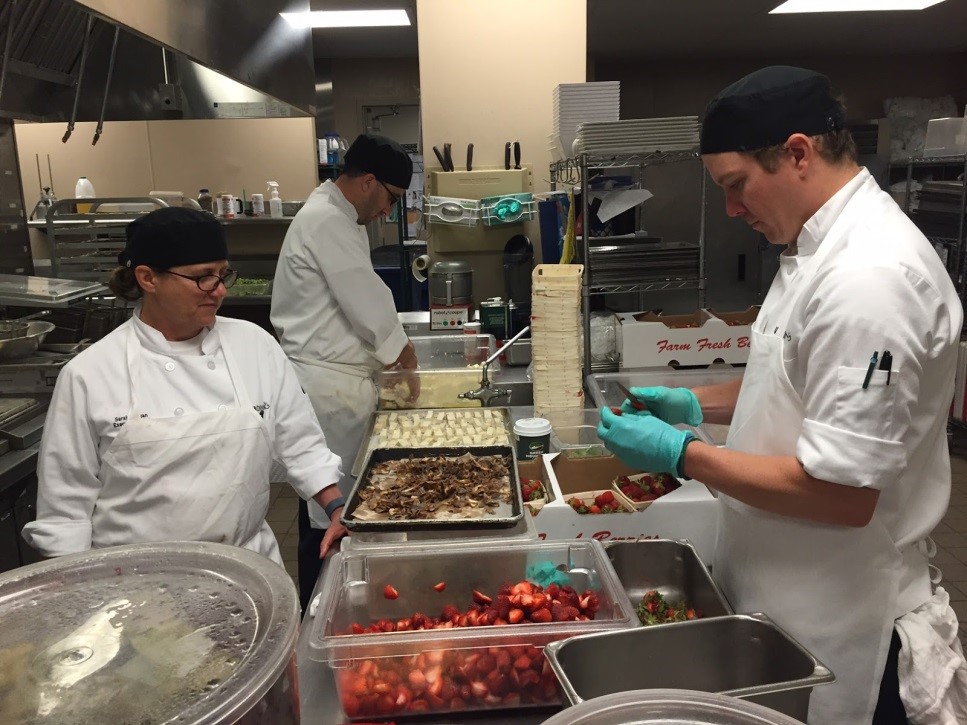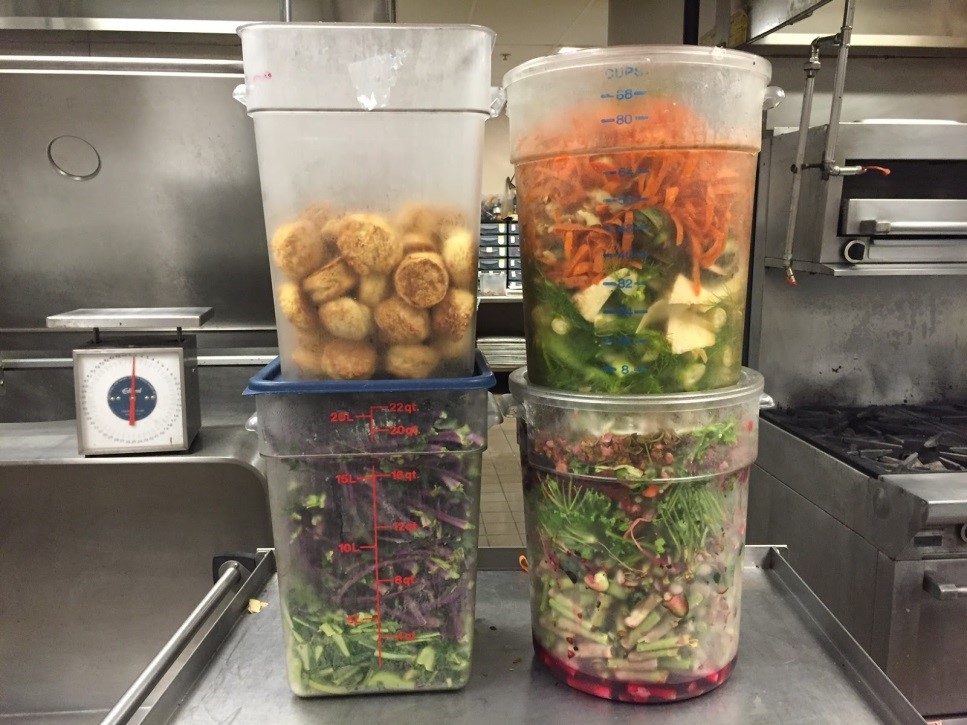By Eva Sherman
UVM hosted this month the 5th Annual UVM Food Systems Summit, which engaged attendees in conversations about “what makes food good?” This included topics of food security, GMOs, and food waste. From the UVM Dining perspective, that last topic was where we turned our focus. While UVM has been donating edible food and composting the rest for years, the event was a chance to take a closer look at operations and audience engagement.

Chefs Sarah, Steve, and Adam carefully minimized and repurposed trim waste. The strawberry tops were used to infuse a lemonade and turnip peels were turned into crisps and offered as a salad topping.
With the topic of wasted food growing in local and national conversations, there was a chance for the Summit to not only feature panels as part of the agenda, but to invite the attendees to participate in a zero food waste event. What better group to participate than those passionate about creating healthy food systems?
What is Zero Food Waste?
The term “zero food waste” does not mean that there is no crumb of food discarded at the end of the day. Rather, by following the tiers of the Food Recovery Hierarchy from the Vermont Agency of Natural Resources, food is channeled to alternate end uses before being composted. Before the start of the Summit, we adapted the Food Recovery Hierarchy to illustrate the specific steps being taken at each level to reduce the food waste at the conference. The graphic was displayed to educate attendees about how the food waste accumulated at the Summit was being thoughtfully managed.
When thinking about excess food, turning to compost seems like the most sustainable option. However, it is important to prioritize reducing the need for composting as an end use and to capture the food that was intended for consumption to more productive channels. The highest priority on the Food Recovery Hierarchy is source reduction. This entails minimizing the potential of having excess food, which can be done in a variety of ways. For the Summit, source reduction was made possible by the intentional menu planning and ingredient sourcing by UVM Dining chefs.
“The menu for this event included many high quality, locally sourced ingredients that we did not want to see going into the compost. By choosing ingredients that could be easily adapted into future meals, we were able to greatly reduce the potential for food waste,” said Executive Chef Sarah Langan.
The Summit attendees were also informed of the zero food waste efforts through real time data reporting at the end of lunch on both days of the conference. Attendees were given updates on the amount of food being either repurposed into other conference meals, donated where possible, fed to chickens on UVM’s Catamount Farm, or composted. Providing updates during meal time was an intentional way to encourage attendees to be mindful of food waste while serving themselves and sharing credit for collectively working to prevent wasted food.
After source reduction, the Food Recovery Hierarchy aims to channel the already produced food to those who need it. All excess food items that were prepared, but did not leave the kitchen for the event, were either repurposed for other meals at the Davis Center Marketplace or donated to the Chittenden Emergency Food Shelf. All vegetable and grain prep waste was donated to the UVM Catamount Educational Farm as feed for chickens. The last step before composting is industrial uses, such as sending out used cooking oil to be turned into biofuel.
Food scraps that could not be channeled into the top tiers of the hierarchy were composted. At UVM all compost is collected, weighed, and sent to Green Mountain Compost. During the Summit, the weighing of the compost happened a few different times in order to measure how much was being composted from prep waste in the kitchen to scraped plates and excess from the buffet line. The catering team devoted time to separately weigh the scraped plate and buffet compost after breakfast and lunch both days.
Making a Difference

Bins of fruit, vegetable, and grain scraps that were collected and donated to Catamount Farm for chicken feed.
Chris Charron of UVM Catering made note of the difference. “In my opinion, the amount of food waste after the meals at this Summit was significantly smaller than what we would usually have at an event of this size. I would say there was around 75 percent less scraped plate waste and around 50 percent less buffet excess going into the compost bins,” Charron said.
An additional aspect to prevent waste from the event was a choice to use durable cutlery rather than compostable; an element that further reduces what is needed to be hauled offsite for processing.
Before the food even reached the event, charts were put up in the kitchen for the chefs to track the end use of different food scraps accumulated during prep. After compiling the data, we found that 50 pounds of food was able to be repurposed for future meals; 25 pounds of food was donated to the Chittenden Emergency Food Shelf; 31 pounds of food was donated as chicken feed; and only 21 pounds of food was composted.
This data shows that apart from the greater amount of food being donated as chicken feed than being donated to people, the numbers follow the path of the Food Recovery Hierarchy. Success!
With the support of the UVM Dining chefs and staff, the 2016 UVM Food Systems Summit was able to serve as a pilot in the opportunity to manage excess food and food scraps in the most sustainable means possible. This zero food waste initiative fit closely with the themes of the Summit and was enthusiastically received by the attendees. Those who were at this year’s conference not only shared delicious, locally sourced meals together, but were mindful of their own impact within the local food system.
Collectively, this conference served to gauge how the pre-event planning, in partnership with UVM Dining and technical assistance from the Vermont Agency of Natural Resources and event coordinators—combined with active audience participation—can raise the bar of sustainable eating, which is an integral component of what makes food good.
-Eva Sherman is a senior studying environmental studies and a UVM Dining sustainability and marketing intern.










